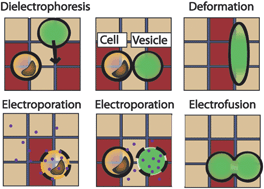We present an integrated platform for performing biological and chemical experiments on a chip based on standard CMOS technology. We have developed a hybrid integrated circuit (IC)/microfluidic chip that can simultaneously control thousands of living cells and pL volumes of fluid, enabling a wide variety of chemical and biological tasks. Taking inspiration from cellular biology, phospholipid bilayer vesicles are used as robust picolitre containers for reagents on the chip. The hybrid chip can be programmed to trap, move, and porate individual living cells and vesicles and fuse and deform vesicles using electric fields. The IC spatially patterns electric fields in a microfluidic chamber using 128 × 256 (32,768) 11 × 11 μm2 metal pixels, each of which can be individually driven with a radio frequency (RF) voltage. The chip's basic functions can be combined in series to perform complex biological and chemical tasks and can be performed in parallel on the chip's many pixels for high-throughput operations. The hybrid chip operates in two distinct modes, defined by the frequency of the RF voltage applied to the pixels: Voltages at MHz frequencies are used to trap, move, and deform objects using dielectrophoresis and voltages at frequencies below 1 kHz are used for electroporation and electrofusion. This work represents an important step towards miniaturizing the complex chemical and biological experiments used for diagnostics and research onto automated and inexpensive chips.

You have access to this article
 Please wait while we load your content...
Something went wrong. Try again?
Please wait while we load your content...
Something went wrong. Try again?


 Please wait while we load your content...
Please wait while we load your content...